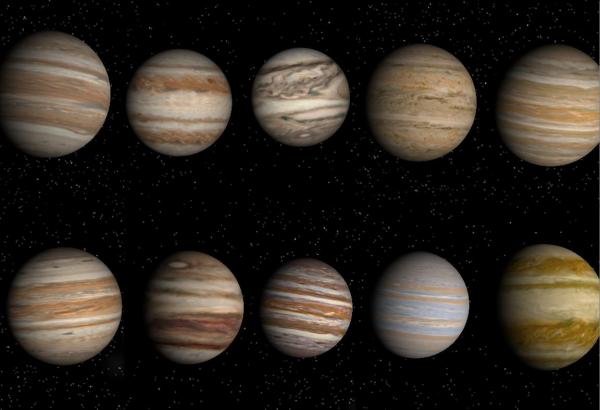BY LETTER
Jovian Class
Gas Giants |
 Image from Steve Bowers |
Also known as Gas Giant. As their popular term indicates, these planets are mainly composed of gases, like H2, He, NH3, CH4, as well as water ice. They are usually quite large compared to terrestrial planets (mass range from 0.2 to 13 Jupiters). A Jovian Class world does not have a solid surface that is visible from orbit. The core is always under very high pressure, and some of the larger gas giants have cores made of metallic hydrogen. Varied in form and size, these are among the most beautiful planets, because of their preponderance towards multiple moons, ring systems, and widely varied color schemes. Other than size, there is no hard and fast distinction between Jovian Class Planet and Brown Dwarf Star.
Gas Giants form beyond the snow line, an have very large fluid envelopes compared to their cores. Some rare, and very ancient gas giants formed around the first generation of very low metallicity stars and have almost no rocky or metallic component. Gas giants are classified in two ways- by temperature, which affects the composition of the cloud layers of the giant in a number of significant ways, and by mass. Examples of each of the temperature classes can be found in any of the size classes, and vice versa, although some size classes are more common at certain temperatures and vice versa.
A typical gas giant may be classified using both size and temperature types to create a subtype, so the full classification might be Meso-EuJovian Subtype (this is the full classification for Jupiter) or Meso-HyperthermalJovian Subtype (the full classification for Behemoth, Hat-P-1B).
Gas Giant Size Classes
Neptunian Class (0.03 to 0.2 Jupiter masses)- MicroJovian Type Small gas giants, with minimal solid core. More information Here
- SubJovian Type Medium sized gas giants, 0.08 to 0.2 Jupiter Masses. Many worlds of this type are outer system cryojovian worlds like Neptune and Uranus. More information here.
- Mesojovian Type Major Type of Jovian Class of planet. Masses from 0.21 to 8.0 that of Jupiter More information here
- SuperJovian Type Jovian worlds with masses from 8.1 to 13.0 that of Jupiter, the theoretical upper limit of planets. Objects more massive than this are classed as Brown Dwarfs. More information here.
Gas Giant Temperature Types
- HyperthermalJovian Type: Very hot gas giants, with temperatures above 1400 Kelvin. Includes so-called 'Puffy worlds' and 'Comet worlds' More Information here.
- EpiStellar Jovian Type: Hot, dark gas giants with temperatures between 900 Kelvin and 1400 Kelvin. More information here.
- AzuriJovian Type Warm clarified blue gas giants with temperatures between 350K and 800K. More information here.
- HydroJovian Type: Temperate gas giants with clouds predominantly consisting of water vapour. More information here.
- EuJovian Type: Cool gas giants, with clouds predominantly consisting of ammonia. More information here.
- CryoJovian Type: Cold gas giants in the outer reaches of a planetary system, generally too cold for clouds to form at all. More information here.
Biospheres
A few gas giant worlds have developed biospheres; these are relatively rare, because the atmosphere of a jovian world is a very dilute resource and many of the necessary elements for life are generally only found in restricted quantities. Some examples of jovian biospheres include- Lontis:
- Angel Hair:
- Ruach:
- and the periodic civilisation known as The Jacks.
Related Articles
Appears in Topics
Development Notes
Text by M. Alan Kazlev
Additional material by Andrew P added Nov 3, 2024
Initially published on 25 November 2001.
Biospheres section by Andrew P added Nov 3, 2024
Additional material by Andrew P added Nov 3, 2024
Initially published on 25 November 2001.
Biospheres section by Andrew P added Nov 3, 2024






